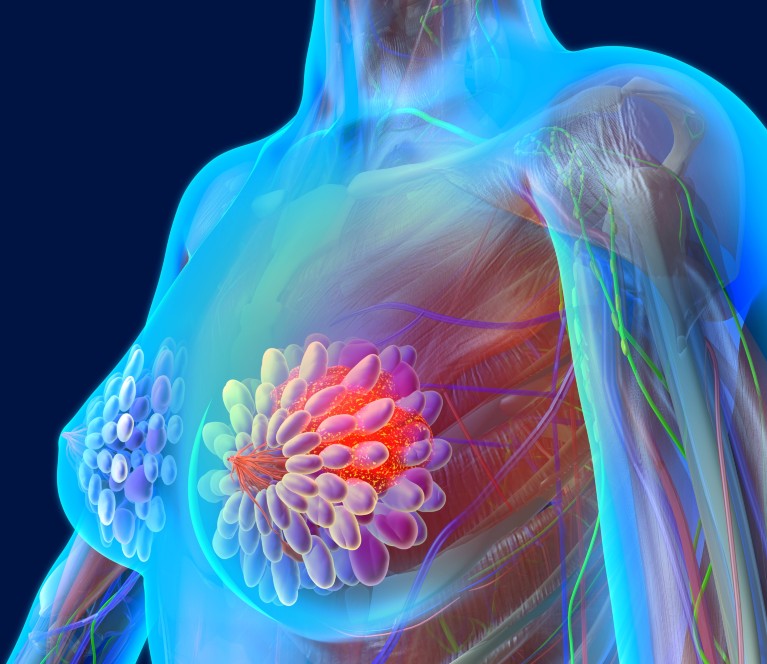
Breast cancer in young women is not a different disease than in older counterparts, but it does present unique challenges for patients and providersCredit: Roger Harris/SPL/Getty Images
In 2016, 21-year-old Jessica Florence found a lump in her right breast. The architectural student at Florida A&M University soon found out that she had stage 3 breast cancer. Despite treatment, her disease later turned into stage 4 metastatic breast cancer. By age 28, the cancer had spread to Florence’s brain and spine.
Breast cancer is a devastating disease at any point in a patient’s life, but for patients under 40, it can present unique challenges.
“It’s not that we think breast cancer is a completely different disease in younger women,” says Ann Partridge, professor of medicine at Harvard Medical School, but it tends to be more aggressive and frequently goes undiagnosed for longer periods. Current screening for breast cancer suggests that women get their first mammogram at age 40 or even later. “So, most young women are not being screened for breast cancer,” Partridge says.
Perhaps most troubling, cases of breast cancer in women under 40 are on the rise, for reasons that remain unclear.
Historically, researchers have directed comparatively little effort to understanding this segment of breast cancer cases, and key questions remain partially unanswered. The impact of pathogenic variants in breast cancer predisposition genes on prognosis and the efficacy of anticancer therapies requires more research. So do survivorship issues, including fertility preservation strategies and the safety of pregnancy after treatment completion.
A series of new studies examines breast cancer in young women, and the results provide much needed insights into the nature of the disease, prognosis and treatments, and the safety of pregnancy.
Looking for molecular differences
To better understand the age-related specificities of breast cancer in young women, scientists first need to characterize the molecular biology of this disease. Although some of the genetic differences between breast cancer in younger and older patients are known, many are not.
Some of the most studied pathogenic variants in breast cancer predisposition genes occur in the BRCA1 and BRCA2 genes. One study found that women with a BRCA1 or BRCA2 variant face breast-cancer risks of 72% and 69%, respectively, and Partridge says, “The prevalence of having a BRCA1 or BRCA2 mutation is more common in our youngest patients.”
Still, BRCA pathogenic variants only appear in 10% to 15% of younger women with breast cancer. Partridge wondered which others might play a role.
In January, Partridge, Nikhil Wagle, a medical oncologist also at Harvard, and a research team published a study in which they applied whole genome sequencing to tumors from 93 breast-cancer patients under the age of 35. They compared the genomes to those from breast-cancer patients over 45, recorded in The Cancer Genome Atlas.
The results showed that younger women with breast cancer more frequently had mutations in two genes: GATA3 and ARID1A. Both of these genes play a role in tumour suppression, and mutations in them could allow the initiation and progression of breast cancer.
In other, previous studies, mutations in GATA3 and ARID1A show an association with cancer. Other studies point to potential treatments. For GATA3 mutations, for example, one study showed that the small molecule, milademetan could be a beneficial adjuvant treatment for these patients. For breast cancer patients with mutations in ARID1A, immune checkpoint inhibitors bear further investigation.
Testing more patients
Despite the rise in breast cancer in young women in the western world, these cases represent only 5% of total breast cancer diagnoses. That can make it difficult for researchers to gather enough data to draw clear conclusions.
To expand the search, Matteo Lambertini, associate professor at the University of Genova, in Italy, and consultant in medical oncology at IRCCS Policlinico San Martino Hospital, and his colleagues worked with 30 healthcare centres around the world to study the results of breast cancer treatment in patients under the age of 40 with a BRCA pathogenic variant. The researchers also collected data on a patient’s hormone-receptor status, positive or negative, which indicates if their cancer can be stimulated by estrogen or progesterone.
Lambertini and his colleagues recently reported their findings from 1,236 female subjects in npj Breast Cancer. The results showed that a recurrence of breast or another form of cancer—usually ovarian—was more likely in patients with a BRCA1 pathogenic variant. Also, patients with hormone-receptor positive disease were more likely to experience a recurrence, and they did not have better prognosis, compared to those with hormone receptor-negative breast cancer.
Based on such findings, “We need to pay more attention to secondary tumours, particularly in the BRCA1 patient population,” Lambertini says. “We may need to counsel a BRCA1 patient more aggressively on the need for preventive measures including risk-reducing strategies.”
Focusing on fertility
While a breast cancer diagnosis will upend anyone’s life, the issues that accompany diagnoses in younger patients can be particularly daunting. “Fertility is particularly pertinent to our youngest patients with breast cancer,” Partridge says.
For those who planned to have children, learning that some oncologists advise against pregnancy after breast cancer treatment can be nearly unbearable.
Young women with a BRCA pathogenic variant may be less fertile.Lambertini and his colleagues also found that fewer oocytes are collected after ovarian stimulation than in a comparable population of breast cancer patients without BRCA pathogenic variants.
But a lot more research remains. Lambertini, Partridge, and a team of researchers recently studied more t han 1,250 young women with breast cancer and a germline BRCA pathogenic variant. They found that pregnancy had no impact on a woman’s likelihood of recurrence and no increased concern of birth defects.
As work continues, Partridge sees some cause for optimism both about the issue of fertility andsurvival. “We know that most young women who get breast cancer will survive,” she says. “We also know that women with a BRCA1 or BRCA2 mutation do just as well as women who don’t have that, as long as they get appropriate therapy.”



